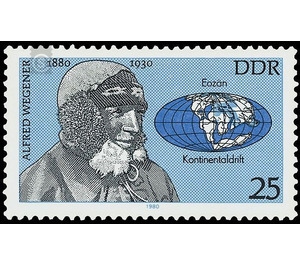Commemorative stamp series - Germany / German Democratic Republic 1980 - 25 Pfennig
Theme: Calender
| Country | Germany / German Democratic Republic |
| Issue Date | 1980 |
| Face Value | 25.00 |
| Color | blue |
| Perforation | K 13:12 1/2 |
| Printing Type | offset |
| Stamp Type | Postage stamp |
| Item Type | Stamp |
| Chronological Issue Number | 2237 |
| Chronological Chapter | GER-DDR |
| SID | 771892 |
| In 16 Wishlists | |
25-pfennig value: Alfred Wegener (November 1, 1880 to the end of November 1930) Alfred Wegener was born in Berlin. His father was the director of the Schindler orphanage, Friedrichsgracht 57. He spent his schooldays in the former Kölln Gymnasium (not far from the Märkisches Museum). In summer, the family lived in the house of the mother's parents, in Zechliner hut (circle Potsdam). Since 1969, an Alfred Wegener memorial has been opened in this house. He studied at the universities of Heidelberg, Innsbruck and Berlin. In Berlin he received the doctoral degree in 1905 with an astronomical dissertation. This was followed by an activity as an assistant at the Aeronautical Observatory Lindenberg. 1906-1908 he participated as a meteorologist on a Danish expedition on the east coast of Greenland. 1906 world record in balloon flight with 52 hours. In 1911 he published a standard work of meteorology "thermodynamics of the atmosphere". On January 6, 1912, he approached the scientific community for the first time with the hypothesis of continental drift in a lecture of the "Geological Association" in Frankfurt / Main. In the same year he published in "Petermann's Mitteilungen" (Gotha) a series of three papers on this topic. In 1913, the Privatdozent Dr. Alfred Wegener participated in a second Greenlandic expedition under Danish leadership, this expedition crossed Greenland for the first time at the height of the 85th latitude. Wounded at the beginning of the First World War, Dr. Wegener his theory of continental drift to a book that appeared in 1915 in first edition and 1920 in a second, revised edition. As early as 1921, the major geologists and geographers in Germany commented in extensive scientific essays on the "theory of displacement" in agreement or disapproval, and Prof. Dr. med. Alfred Wegener explained "The Theory of Continental Shifts", including all arguments and new observation results. The important thing about this hypothetical-theoretical view was that the image of the position of the continents and oceans of our earth was also understood as a constantly changing process of natural historical development. The third edition of the book (1922) was followed by translations into the Russian, English, French, Spanish and Swedish languages. In 1929, the fourth and last issue of this book by Alfred Wegener, who no longer returned alive from his Greenland expedition (1929-1930). Only ten years Alfred Wegener was able to teach and work as a university professor (1919-1924 Hamburg, 1924-1929 Graz / Austria). The modern satellite observations and the research of the sediments of the oceans have fully confirmed the theory of Alfred Wegener. Today it is an essential part of the theories complex of global plate tectonics.


